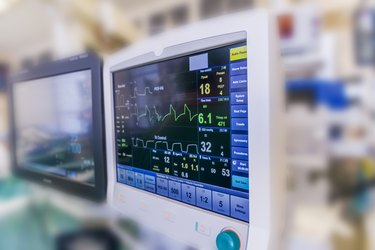
If you're a patient staying in the hospital or visiting someone who is, you may wish you could better understand the monitors beeping beside the bed.
Two common readings taken from patients in a hospital are heart rate (measured by electrocardiogram) and blood pressure, per Oklahoma Heart Hospital. In order to understand these readings, you need to know what each wave of the electrocardiogram means, as well as the ranges of systolic and diastolic blood pressure.
Video of the Day
Video of the Day
Before we get into those numbers, remember that only a medical professional can make a diagnosis from this data.
How to Read a Hospital Heart Monitor
A heart monitor, also known as an EKG, ECG or electrocardiogram, displays the electrical activity of the heart. Doctors, nurses and other medical professionals are required to undergo many hours of training in EKG interpretation prior to using an EKG as a guideline to administer, adjust or prescribe treatments. The average person, on the other hand, can learn the basics for purely academic or interest purposes or as a building block for further study.
1. Locate the Flat or Wavy Line Between the Peaks
This section ends at the first rise or dip of the beat and measures the depolarization of the atria, which means a heart muscle contraction, according to a July 2020 article in StatPearls. The time from the start of the bump before the peaks (called the P wave) to the first Q or R wave should be between .12 and 2 seconds.
2. Locate the First Dip or Spike of the Heartbeat
If it's a dip, this is a Q wave, which is a downstroke. If it's a spike, this is an R wave, which is an upward deflection. Q waves can be a sign of a heart attack, or they can be normal. Only a doctor can make the determination.
3. Check for a Downward Stroke After an R Wave
If present, this is an S wave. The entire readout of these three waves is called the QRS complex, and it should last .08 to .12 seconds in a healthy individual.
4. Locate the Flat or Wavy Line After the QRS Complex
This is the T wave, and it measures ventricular repolarization, which is the relaxing of the heart muscle.
Related Reading
How to Read Blood Pressure on a Hospital Monitor
1. The Top Number Is Systolic Pressure
Locate the top number of the two numbers. This is the systolic blood pressure, which represents pressure within the heart during a beat. A healthy systolic pressure should be between 90 and 120, per the Mayo Clinic.
2. The Bottom Number Is Diastolic Pressure
Locate the bottom number of the two numbers. This is the diastolic blood pressure, or the pressure between heartbeats. A healthy diastolic pressure should be between 60 and 80.
Use the first number as the systolic pressure and the second number as the diastolic pressure if the reading is taken using a blood pressure cuff instead of a machine.

Tip
Use these measurements as a general guide, but leave the diagnosis up to a medical professional.
Is this an emergency? If you are experiencing serious medical symptoms, please see the National Library of Medicine’s list of signs you need emergency medical attention or call 911.